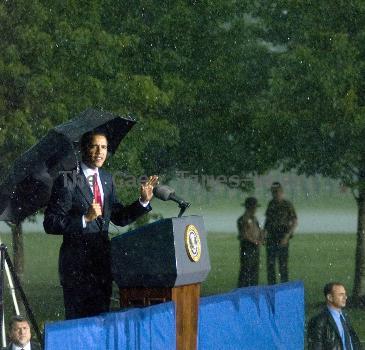BP to pump cement into blown-out Gulf of Mexico oil well, coast still faces long recovery
By Harry R. Weber, APThursday, August 5, 2010
BP to pump cement into blown-out Gulf oil well
NEW ORLEANS — BP planned to start pumping cement into its blown-out oil well in the Gulf of Mexico on Thursday, following up on a key development in the effort to kill the well when mud that was shoved in successfully held back the flow of crude.
After a series of unsuccessful attempts to stem the flow of oil a mile underwater, the tide appeared to be turning in the months-long battle to stop the massive oil spill.
BP PLC said Wednesday it was finally able to force the oil back down to its underground reservoir with a slow torrent of heavy mud in an early step toward plugging the well up for good.
The news came as a federal report indicated only about a quarter of the spilled oil remains in the Gulf and is degrading quickly, with the rest contained, cleaned up or otherwise gone.
But for the people who lost their livelihoods or still see oil washing up on their shores, the news is little consolation.
“There are still boats out there every day working, finding turtles with oil on them and seeing grass lines with oil in it,” said charter boat captain Randy Boggs, of Orange Beach, Ala. “Certainly all the oil isn’t accounted for. There are millions of pounds of tar balls and oil on the bottom.”
Harry “Cho-cho” Cheramie, a 59-year-old shrimper who grew up on the deck of his father’s shrimp boat, said he’s also got good reason to be skeptical.
“I don’t think we’ve finished with this,” he said in Grand Isle, La. “We haven’t really started to deal with it yet. We don’t know what effect it’s going to have on our seafood in the long run.”
Despite the progress in the mud-pumping effort known as the “static kill,” BP executives and federal officials won’t declare the threat dashed until they use the relief well — though they haven’t publicly agreed on how to do it.
Federal officials including spill response commander Thad Allen, a retired Coast Guard admiral, insist that crews will shove mud and cement into the reservoir feeding the well through the 18,000-foot relief well, which should be completed within weeks.
But for reasons that were unclear, BP officials have in recent days refused to commit to pumping cement down the relief well, saying only that it will be used in some fashion. BP officials have not elaborated on other options, but those could include using the well simply to test whether the reservoir is plugged.
“We have always said that we will move forward with the relief well. That will be the ultimate solution,” BP Senior Vice President Kent Wells said Wednesday afternoon. “We need to take each step at a time. Clearly we need to pump cement. If we do it from the top, we might alter what we do with the relief well, but the relief well is still a part of the solution. The ultimate objective is getting this well permanently sealed.”
Whether the well is sealed or not, there’s still oil in the Gulf or on its shores — nearly 53 million gallons of it, according to the report released Wednesday by the Interior Department and the National Oceanic and Atmospheric Administration. That’s still nearly five times the size of the Exxon Valdez spill, which wreaked environmental havoc in Alaska in 1989.
But almost three-quarters of the nearly 207 million gallons of oil that leaked overall has been collected at the well by a temporary containment cap, been cleaned up or chemically dispersed, or naturally deteriorated, evaporated or dissolved, the report said.
The remaining oil, much of it below the surface, remains a threat to sea life and Gulf Coast marshes, NOAA Administrator Jane Lubchenco said. But the spill no longer threatens the Florida Keys or the East Coast, the report said.
President Barack Obama, while noting that people’s lives “have been turned upside down,” declared that the operation was “finally close to coming to an end.”
An experimental cap has stopped the oil from flowing for the past three weeks, but it was not a permanent solution.
The static kill — also known as bullheading — probably would not have worked without that cap in place. It involved slowly pumping the mud from a ship down lines running to the top of the ruptured well a mile below. A similar effort failed in May when the mud couldn’t overcome the flow of oil.
Contributing to this report were Associated Press writers Jennifer Kay in Pensacola Beach, Fla., Mary Foster in Grand Isle, Tamara Lush in Tampa, Fla., Annie Greenberg in Miami, and Jay Reeves in Birmingham, Ala.
Tags: Accidents, Alabama, Barack Obama, Coastlines And Beaches, Environmental Concerns, Florida, Louisiana, New Orleans, North America, United States

